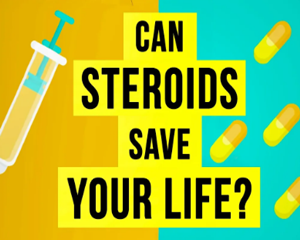Steroids: they're infamous for their use in sports.
类固醇:这类物质在体育赛事中的使用早已臭名昭著。
But they're also found in inhalers, creams to treat poison ivy and eczema, and shots to ease inflammation.
但它们也常见于吸入器,治疗藤毒和湿疹的药膏,以及缓解炎症的注射液中。
The steroids in these medicines aren't the same as the ones used to build muscle.
这些药物中的类固醇和用于促进肌肉生长的类固醇不同。
In fact, they're all based on yet another steroid -- one our body produces naturally, and we can't live without.
实际上,它们都是基于另一种类固醇物质--我们人体可以自然合成,且维持生命所必需的类固醇。
Taking a step back, the reason there are so many different steroids is because the term refers to substances with a shared molecular structure, rather than shared effects on the body.
退一步说,类固醇种类繁多的原因是类固醇这一专有名词泛指具有共同分子结构,而非对人体造成相同影响的物质。
Steroids can be naturally occurring or synthetic,
类固醇可以天然存在或是通过人工合成,
but what all steroids have in common is a molecular structure that consists of a base of four rings made of 17 carbon atoms arranged in three hexagons and one pentagon.
但所有类固醇物质的共同特性是它们的分子结构,这种分子结构由4个环(共17个碳原子)组成:3个六碳环和1个五碳环。
A molecule must contain this exact arrangement to be a steroid, though most also have side chains -- additional atoms that can dramatically impact the molecule's function.
一个分子必须具有这样精确的排列才能被称作为固醇类物质,尽管大多数分子也含有侧链--这些额外的原子可以极大改变分子的功能。
Steroids get their name from the fatty molecule cholesterol. In fact, our bodies make steroids out of cholesterol.
类固醇的命名源于脂肪分子胆固醇。实际上,我们人体会从胆固醇中生成类固醇。
That fatty cholesterol base means that steroids are able to cross fatty cell membranes and enter cells.
脂肪胆固醇基底能够让类固醇物质穿过脂肪细胞膜并进入细胞。
Within the cell, they can directly influence gene expression and protein synthesis.
在细胞内,它们可以直接影响基因表达和蛋白合成。
This is different from many other types of signaling molecules,
这和许多其它的信号分子不同,
which can't cross the cell membrane and have to create their effects from outside the cell, through more complicated pathways.
因为后者无法穿过细胞膜,只能通过更加复杂的方式在细胞外产生作用。
So steroids can create their effects faster than those other molecules.
所以相比其它分子,类固醇可以更快的产生作用。
Back to the steroids in anti-inflammatory medications: all of these are based on a naturally occurring steroid called cortisol.
说回消炎药中的类固醇:这类类固醇都是基于一种天然存在的类固醇,即皮质醇。
Cortisol is the body's primary stress signal, and it has a huge range of functions.
皮质醇是人体的主要压力信号,并且具有很多功能。
When we experience a stressor -- anything from a fight with a friend, to spotting a bear, to an infection or low blood sugar
每当我们经历一种应激源--比如和朋友的一场争执,突然发现一头熊,感染或低血糖,
the brain reacts by sending a signal from the hypothalamus to the pituitary gland.
大脑就会通过下丘脑向脑垂体发出信号来做出反应。

The pituitary gland then sends a signal to the adrenal glands. The adrenal glands produce cortisol, and release some constantly.
随后,脑垂体向肾上腺发送信号。最终肾上腺产生皮质醇,并不断进行释放。
But when they receive the signal from the pituitary gland, they release a burst of cortisol, which spurs the body to generate more glucose for energy,
但是当肾上腺从脑垂体接收到信号时,它们所释放的大量皮质醇会刺激人体产生更多的葡萄糖作为能量来源,
decrease functions not immediately related to survival, like digestion, and can activate a fight-flight-or-freeze response.
降低与生存没有直接关系的功能运作,比如消化,并且能激活人体的“战斗、逃跑或原地不动”反应机制。
This is helpful in the short term, but can cause undesirable side effects like insomnia and lowered mood if they last too long.
这在短期内很有帮助,但如果持续时间太长,将可能导致一些副作用,诸如失眠症和情绪低落。
Cortisol also interacts with the immune system in complex ways -- depending on the situation, it can increase or decrease certain immune functions.
皮质醇同样也和免疫系统有着复杂的相互作用--根据实际情况,皮质醇可以加强或降低一定的免疫功能。
In the process of fighting infection, the immune system often creates inflammation.
在人体抵抗感染的过程中,免疫系统通常会产生炎症。
Cortisol suppresses the immune system's ability to produce inflammation, which, again, can be useful in the short term.
皮质醇能够抑制免疫系统产生炎症的能力,但同样仅在短期内有效。
But too much cortisol can have negative impacts, like reducing the immune system's ability to regenerate bone marrow and lymph nodes.
过多的皮质醇对人体具有负面影响,例如降低免疫系统再生骨髓和淋巴结的能力。
To prevent levels from staying high for too long, cortisol suppresses the signal that causes the adrenal glands to release more cortisol.
为了防止皮质醇的含量长时间处于过高水平,皮质醇会抑制引起肾上腺释放更多皮质醇的信号。
Medicinal corticosteroids channel cortisol's effects on the immune system to fight allergic reactions, rashes, and asthma. All these things are forms of inflammation.
药用皮质类固醇可通过引导皮质醇对免疫系用的作用来对抗过敏反应、皮疹和哮喘。所有这些都是炎症的不同表现形式。
There are many synthetic steroids that share the same basic mechanism:
很多合成类固醇也有着相同的基础作用机理:
they enhance the body's cortisol supply, which in turn shuts down the hyperactive immune responses that cause inflammation.
它们促进人体的皮质醇供应,进而阻止了引发炎症的过度免疫反应。
These corticosteroids sneak into cells and can turn off the "fire alarm" by suppressing gene expression of inflammatory signals.
这些皮质类固醇潜入细胞中,通过抑制炎症信号的基因表达来关闭细胞的“警报”。
The steroids in inhalers and creams impact only the affected organ -- the skin, or the lungs.
吸入器和药膏中的类固醇仅影响着一个器官--皮肤或是肺部。
Intravenous or oral versions, used to treat chronic autoimmune conditions like lupus or inflammatory bowel disease, impact the whole body.
常用于治疗慢性自身免疫性疾病(例如狼疮或炎症性肠病)的静脉注射或口服形式的类固醇则能对全身造成影响。
With these conditions, the body's immune system attacks its own cells, a process analogous to a constant asthma attack or rash.
在患有此类疾病的情况下,人体免疫系统会攻击自身细胞,这是一个类似于哮喘频繁发作或皮疹不断复发的过程。
A constant low dose of steroids can help keep this renegade immune response under control
恒定低剂量的类固醇能有助于控制上述叛逆的免疫反应,
but because of the negative psychological and physiological effects of longterm exposure, higher doses are reserved for emergencies and flare-ups.
但对于因长期暴露于高剂量所产生的负面身心影响,较高剂量的类固醇通常只被用于应对紧急和突发事件。
While an asthma attack, poison ivy welts, and irritable bowel syndrome might seem totally unrelated, they all have something in common: an immune response that's doing more harm than good.
尽管哮喘发作、藤毒红肿,以及肠易激综合症可能看似毫不相关,但它们实际有着共性:都是一种弊大于利的免疫反应。
And while corticosteroids won't give you giant muscles, they can be the body's best defense against itself.
虽然皮质类固醇无法赐予你健硕的肌肉,但它们却是人体抵抗自身伤害的最佳防御工具。












